I'll be speaking at Second Wind's 'YA2 - Your Agency Empowered' Event on 2/27/2013. My topic is "The Inbound Mandate". (Tony Mikes came up with the title. Not me. But, I like it very much.) There will be 100 agency principals in attendance, who have built very successful businesses by providing all kinds of advertising and marketing services to their clients over the last few decades.
Per Tony's request, I will be speaking about why every agency should be offering inbound marketing services and doing inbound marketing for themselves. Patrick Shea (@mpatrickshea), the team at Second Wind (@secondwindbuzz) and I have been working together on the contents of the presentation. Tony will be giving an introduction to what inbound marketing is. I'll be talking about why and how it's different than other ways of advertising and marketing, as well as why agencies should invest in inbound marketing.
What is Inbound Marketing?
Inbound marketing (wikipedia) is a term that can mean different things to different people. At HubSpot, we've created the inbound marketing methodology, which is what inbound marketing means to us. For the last year or two, I've explained it in 5 steps.
- Attract traffic
- Convert visitors into leads
- Convert leads into sales
- Retain, upsell and cross-sell to existing customers.
- Analyze each activity for continuous improvement.
And here's the current official explanation of the inbound marketing methodology:
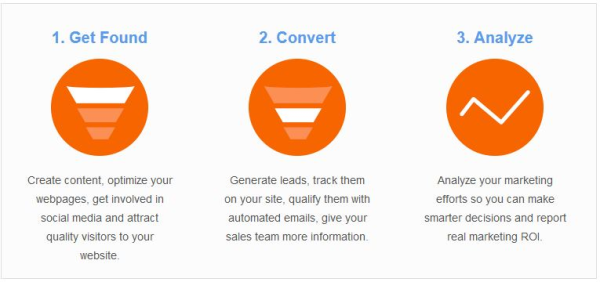
(Source: HubSpot's Inbound Marketing Methodology)
We will be launching an expanded version of the methodology that is a bit more inline with my 5 steps above.
9 Reasons to Invest in Inbound Marketing...
Typically, when we talk about inbound marketing, we contrast it's permission based nature with traditional advertising's interruptive nature. (See the table below.) We talk about how consumers skip over TV ads, avoid radio in favor of their iPod playlists and read their rss feed over a cup of coffee in lieu of the daily newspaper - as examples of how consumers are tuning out traditional advertising. We talk about how corporate buyers recycle direct mail before they read it, screen cold calls, click the spam button on unsolicited email messages and 'google it' before they consult an archive of trade publications - as examples of how corporate buyers aren't easily reached by traditional sales and marketing approaches anymore.
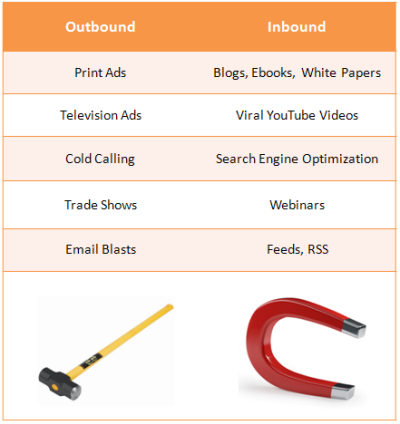
(Source: Inbound Marketing as the Next Phase of Web Marketing)
All of these trends have far reaching implications for media companies, marketers, salespeople and of course, agencies. But, if we only cite changing 'consumer buying processes' as the reason to adopt inbound marketing, we would be overlooking much of it's power and potential impact. In the 5+ years I've been working at HubSpot, we've come up with 9 additional reasons why inbound provides a superior foundation for marketing any business or product.
1. Inbound Marketing is Predictable.
Inbound marketers don't have a crystal ball, but some might consider it witchcraft. Not only are there loads of data that show the correlation between inbound marketing effort and inbound marketing results, a skilled inbound marketer can also assess a company's marketing assets and predict how fast they can grow traffic, leads and sales with those assets. For example, if a company has lots of great blog content but it's not optimized for search; has great white papers that available for download without a form completion required; has no social sharing buttons on their site; has a large social media following but isn't sharing content with them - an inbound marketer can use competitor data, analytics data, keyword research data and harness this inventory of under-utilized assets to predict results. They can predict lifts in traffic from search and social sources; improvements in lead yield through proper use of calls to action, landing pages and offers; and improvements in customer acquisition rates by properly training their sales and marketing team to use marketing automation, personalization, lead intelligence and inbound sales approaches.
2. Inbound Marketing is Trackable.
Want to know how many visitors, leads and sales that tweet generated? Want to know which keywords generate the most qualified leads? Want to know whether that blog post influenced a sale? Want to know which blog post topics received the least amount of inbound links, comments, views or call-to-action clicks? (See table below as an example.)
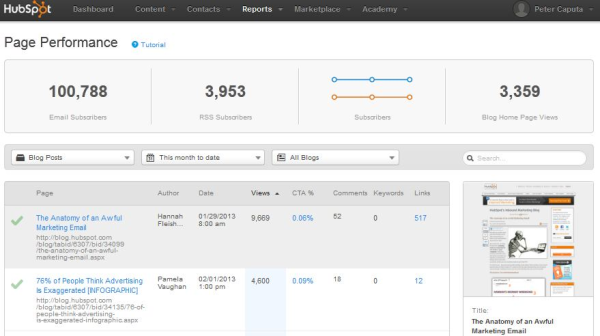
(Source: Screen grab from HubSpot's Inbound Marketing Blog's Blog Analytics)
Want to know which landing page has the highest visitor-to-lead conversion rate? Want to know which source of traffic converted at the highest rate on a given landing page? Want to know which lead nurturing sequence received the highest click through rate? Want to know which email campaign caused the most unsubscribes? Want to know which pages on your site are viewed most often - right before people buy your product?
SEO, social media, PPC, lead generation, marketing automation, email marketing, paid online marketing... Do you want to track the results driven by each of these activities? Done. Some other marketing or advertising method you want to track online? Done. If you use the right marketing software, it's all trackable.
3. Inbound Marketing Efforts Can Be Directly Attributed to Revenue.
Because everything is trackable, inbound marketing activities can be attributed to dollars. In fact, inbound marketers' keystrokes are measured in dollars. (Okay. Not really. But, it's darn close.) We call this closed-loop analytics and closed-loop analytics empower marketers to tie their inbound marketing activities directly to the revenue it produces.
As you might imagine, you can track the journey of your individual contacts as they interact with you or each of your marketing assets. (See image of lead intelligence below.) It sounds creepy to some, but as soon as a visitor shares their email address, you can start tying their activity back to their individual record. From there, you can see what emails they open, what pages they view, what web elements they click, how they interact with any other [mobile or web] app you control, what keywords they mention on social media, what blog posts they comment on, what forms they complete, etc.
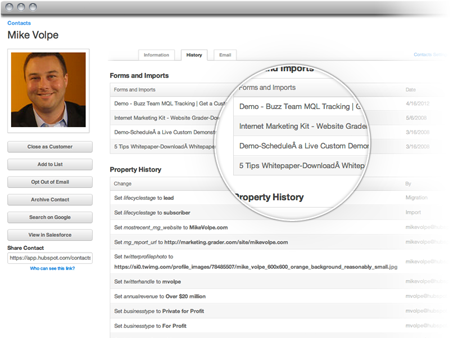
(Source: HubSpot's Lead Tracking & Intelligence.)
As they move through their buying process, from research to purchase, you can sync your marketing messages and sales calls to their interests and readiness for contact. You'll not only know when and how much they spend with you, but also how and why it happened. With inbound marketing, marketing is no longer fuzzy; it drives revenue in a predictable and trackable manner.
4. Inbound Marketing Only Requires Small Bets that Can Each Generate Big Returns.
Most advertising expenditures require that companies make big bets. At the far extreme, Super Bowl ads cost Millions of dollars to produce and then millions of dollars to air. (Can you imagine what you could do if you could spend $4M on inbound marketing?) But, even smaller advertising expenditures are still expensive compared to the small bets inbound marketers make every day at very low effort and with virtually no marginal cost. For example, you can't place your ad in the yellow pages for just one week. Even if you want to produce a TV spot for a local cable channel, you still have to hire a producer, writer and videographer and then pay the station a minimum amount of money to air it. Newspaper ads, magazine ads and even trade shows and direct mail are expensive and require a relatively large committment of time and money.
Inbound marketing does not even require you to invest thousands - let alone millions - in order to generate returns on your investment in time and money. Once you've set yourself up with the proper foundation - the right messaging and branding; social media profiles; a website optimized for search, social and lead generation; the right inbound marketing software for personalization and analytics - you can make really small bets that produce big returns. Some of these small bets - like blog posts, tweets and landing pages - will not work out. Some will hit it big. But your odds are much better than they are at the high-priced-big-buy-in tables of traditional advertising.
For example, you could spend 2 hours writing a blog post that goes viral on social media, gets shared by hundreds of people and attracts dozens of inbound links from thought leaders in your space. You could create an offer and a landing page that converts visitors at a really high rate. You could create an email campaign that receives a really high click-through rate. You could create a nurturing sequence that turns lots of weak leads into qualified leads for your sales team. You could create such a personalized experience on your website that your prospects are compelled to visit your website more frequently, moving further down the funnel with each visit.
Many inbound marketing agencies run thematic inbound marketing campaigns. It's not just about randomly writing blog posts and randomly creating ebooks on random topics. Inbound marketing campaigns are used to launch new products, build demand for refreshed products, enter new verticals, enter new geographies, influence different buyer personas and demographics and recruit employees, just like traditional ad campaigns are used. They're just significantly less costly to create and launch and can have significant upside when they're done right.
5. Inbound Marketing Creates the Foundation for Generating a Measurable ROI from Advertising.
Because individual inbound marketing activities and campaigns - like writing a blog post or launching a new landing page - require very low investments in time and money to produce and launch, they represent a perfect testing ground for concepts, ideas and messaging. These efficient little inbound marketing experiments - if you will - obviate the need for hours of creative brainstorming, pitch deck creation, free spec work, focus groups, concept revisioning and approval rounds that agencies must go through before launching a campaign. Even for companies that will continue investing heavily in traditional advertising, inbound marketing should be the proving grounds. Inbound marketing creates the opportunity for small experiments to test creative before big risky investments are made in traditional advertising.
Further, inbound marketing assets, like blog posts and landing pages, become the object that those campaigns promote. In other words, your call to action - whether it's a QR code on a billboard, a super blow ad, or the the text copy on a pay-per-click ad - should include a call-to-action that leads prospects online.

(Source: Outdoord advertising Requires Distinct Calls to Action)
While I've never been able to effectively scan a QR code on a billboard, I'd be willing to wager that advertising's purpose in the future will shift from creating 'awareness' to promoting offers and content that are accessible online. Companies like Outbrain and Sharethrough and publishers like Buzzfeed and Forbes are creating 'native advertising methods' that make the content the ad and the ad the content. The potential of native advertising to produce predictable, measurable and improvable returns when paired with inbound marketing will make traditional forms of advertising less and less attractive. Even less attractive than they are today...
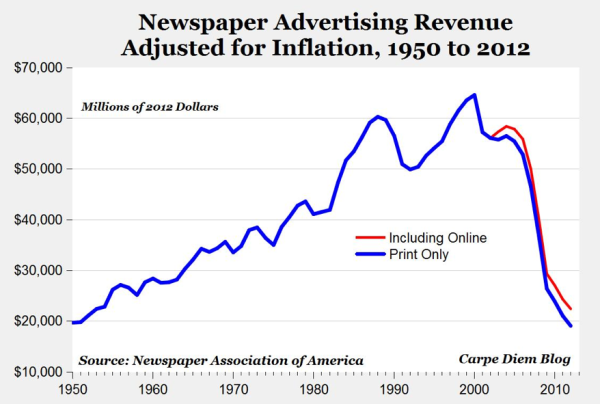
(Source: Newspaper Association of America via Business Insider.)
6. Inbound Marketing Creates Content That Will Have a Positive Impact on Your Business Long into the Future.
Once a blog post, tweet or landing page is published to the web, it's there forever (unless you take it down for some stupid reason). (In the screenshot below, you can see that an article I published in 2008 has been viewed more 83,291 times.) Once an article you've published ranks well for an important keyword phrase, it [usually] doesn't take much effort to maintain that keyword ranking and the traffic that it generates.
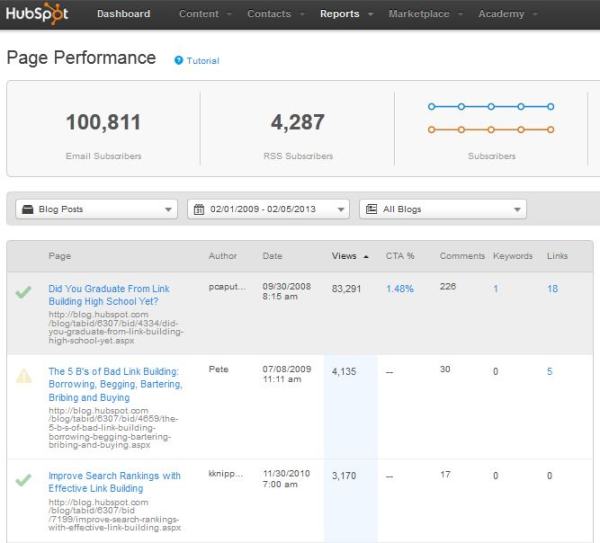
(Source: Screen shot of HubSpot's blog analytics for articles mentioning "link building".)
Once you've created an effective lead generation campaign using pay-per-click-advertising, it usually only requires minor tweaking to continue generating qualified leads. Once you figure out calls to actions and conversion paths throughout your site, they'll generally keep working for a long time. Once a lead nurturing sequence is created, it can be used well into the future to nurture current and future contacts.
Inbound marketing creates assets that work long into the future to help your business generate traffic, leads, sales and loyal customers.
7. Inbound Marketing Attracts a Global Audience.
This past week, I hosted an informal call with Co-Grow member agencies where Dave Kaupp (@dkaupp) from Consilium Global Business Advisors gave a talk about the default global awareness that inbound marketing creates. During the call, we asked the members to look up how many of their site visitors come from outside of the United States. Tracy Dimarino Lewis (@Tracy_J_Lewis) from PR 20/20 said that 51% of their traffic comes from outside of the United States. I've seen similar numbers from other companies. At HubSpot, our Massachussetts based sales and marketing team generated 10% of our sales last year outside of the US. We opened our first overseas office in Dublin, Ireland this past month. About 40% of our leads comes from outside of the US and we plan to scale our International sales to 30% of our new customers by the end of the year.
A global audience is a byproduct of inbound marketing. What would the cost of targeting an international audience be before inbound marketing?
8. Inbound Marketing Analytics Enable Improvement Over Time.
Peter Drucker once said, "If you can measure it, you can manage it." I think he would have an excellent inbound marketer. Since indvidual sales can be attributed back to individual inbound marketing campaigns, results can therefore be improved over time.
There are key metrics that are important in sales and marketing. When a buyer begines interacting with an inbound-marketing-powered company, they start out as site visitors and turn into contacts. Contacts continue on to become marketing qualified leads and then sales qualified leads. Sales qualified leads move through various opportunity stages such as "qualified," "committed" or "closed won". Customers become long term customers and hopefully, evangelists. Each of these stages has two important numbers: conversion rate and volume. For example, a company can turn 3% of their 10,000 visitors into 300 contacts every single month. They then can turn 30% of their 300 new contacts into 100 marketing qualified leads every month.
Once these numbers are established for each stage of the funnel, a marketing and sales team can then go through and systematically improve each of these numbers. Using the example above, that company's marketing team could improve their visitor to contact conversion rate to 4% and generate 400 contacts each month instead of 300 contacts each month by simply launching more offers, landing pages and calls to action. (See screenshot below.)
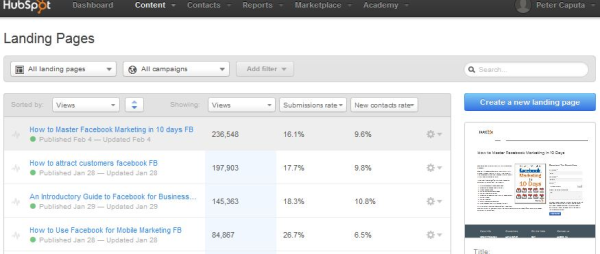
(Source: Screen shot of landing page dashboard showing multiple landing pages and their conversion rates.)
There are multiple ways to improve conversion rates through every stage of the funnel. Some are sales driven. Some are marketing driven. Some require collaboration between the two. Either way, inbound marketing provides a system that smart sales and marketing professionals can use to grow their revenue over time. Like a strong sales team has done alone historically, inbound marketing coupled with inbound sales can create a predictable revenue growth engine.
9. Inbound Marketing Results are Cumulative & Compounding.
As we've established above, every inbound marketing asset you create provides returns long into the future. Therefore, every time you create a new asset, you create more potential for future returns... not unlike how adding money to a savings account generates more interest. With each asset you add to your inbound marketing portfolio, you attract new visitors, new leads and ultimately, new customers who bring new streams of revenue.
But, let's say you managed to save $100,000k in your savings account. You wouldn't leave it in there, would you? No. You'd find better ways to put that capital to use. Smart inbound marketers do the same thing. They leverage their previous returns to make their next investment generate better returns, just like a smart investor would put some of their capital in investment vehicles that generate better, long term returns.
For the most part, this happens automatically with inbound marketing, though, which obviously makes it even easier. There are lots of examples of how inbound marketing is like a cumulative compounding investment vehicle. For example, once you write blog posts, those blog posts get people to subscribe to the blog. Then, when you publish your next blog post, it will be read by those subscribers who, in turn, might share new blog posts with more people, generating even more traffic and subscribers. (See chart below.) Another example is Google's pagerank: once a website has a high pagerank authority, anything else published to that website is more likely to rank well in search results.

(Source: Screenshot of HubSpot's Inbound Marketing Blog Growth showing compounding growth rates as a result of consistent publishing, subscriber growth, search rankings and social shares.)
Every blog post is an opportunity to rank for a new keyword phrase. Every great article you publish can attract a new link. Every new keyword will bring new search traffic. Every new link will bring more referral traffic. Every social media follower is someone who might share your content with their followers (who in turn, might follow you and share your future content with their followers). Every new landing page creates another opportunity to convert visitors into leads, and creates an offer that your email subscriber might share with their peers. Every new sales qualified lead will most likely introduce their co-workers to your content and company. Every new customer can become an evangelist. Long story short: the more assets you have, the more value each asset can generate.
Not only do inbound companies create predictable revenue growth, they create ones that produce cumulative, compounding revenue growth. Some call that hockey stick. Do you want hockey-stick growth?

(Source: HubSpot's growth curve as of October 2010.)
(Thanks to Matt Wainwright (@mdwainwright) and Patrick Shea (@mpatrickshea) for their help thinking through and proofing this post.)

 The future of marketing belongs to the hybrids.
The future of marketing belongs to the hybrids. That’s so far from the truth—if you’re smart.
That’s so far from the truth—if you’re smart.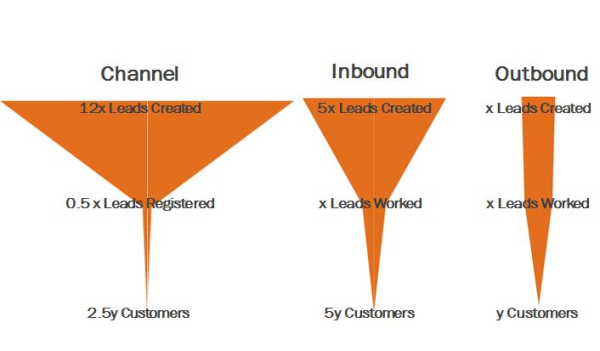

 Once you've got your salespeople to come around to the idea of inbound marketing, what do you do with their content ideas? If your salespeople followed the "
Once you've got your salespeople to come around to the idea of inbound marketing, what do you do with their content ideas? If your salespeople followed the " Sound nuts? Well that's precisely what Beth Comstock, GE's CMO says they are intent on doing. In a
Sound nuts? Well that's precisely what Beth Comstock, GE's CMO says they are intent on doing. In a  With a degree in journalism, Brianne has more than six years of professional writing and content marketing experience. Through web and editorial writing, she reaches target audiences for Fortune 1000 companies, as well as small businesses.
With a degree in journalism, Brianne has more than six years of professional writing and content marketing experience. Through web and editorial writing, she reaches target audiences for Fortune 1000 companies, as well as small businesses.  Does your business need a mobile app? Before investing a lot of resources into developing a mobile app, be sure that it's the right thing for your company and your audience.
Does your business need a mobile app? Before investing a lot of resources into developing a mobile app, be sure that it's the right thing for your company and your audience.








